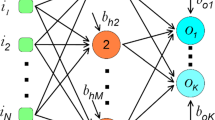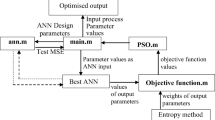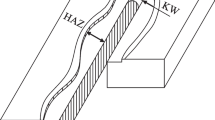Abstract
The present study is aimed to investigate micro-milling performance of thermoplastics with different parameters, namely laser beam absorptivity, latent heat of vaporization, laser power and cutting speed. The 25-W CO2 (CW) laser engraving machine is used for the investigation. In total 50 different combinations of laser power and cutting speed with four categories of thermoplastics, namely poly-methyl-methacrylate, poly-propylene, acrylonitrile butadiene styrene and nylon 6, are used in this study. Experimental results suggest that laser beam absorptivity, cutting power and cutting speed are the major influencing parameters on depth of cut. Theoretical model for the prediction of depth of cut in terms of material properties, cutting power and cutting speed has been proposed. Two correction parameters have been introduced in this analysis using non-linear regression method to improve the theoretical model. Comparison has been made between prediction capabilities of theoretical model, model based on multi-gene genetic programming and artificial neural network. The comparison clearly indicates that all the three models provide accurate prediction of depth of cut. The details of experimentation, model development, testing and the performance comparison are presented in this paper.
Similar content being viewed by others
References
Dahotre N, Harimkar S (2008) Laser fabrication and machining of materials. Springer, USA, pp 34–37
Davim JP, Oliveira C, Barricas N, Conceicao M (2007) Some experimental studies on CO2 laser cutting quality of polymeric materials. J Mater Process Technol 198:99–104
Mustafa K, Kaynak Y, Bagci E, Demirer H, Kurt M (2008) Dimensional analyses and surface quality of the laser cutting process for engineering plastics. Int J Adv Manuf Technol 41:259–267
Ready JF (2001) LIA handbook of laser materials processing. Laser Institute of America, USA, pp 530–533
Norikazu T, Shigenori Y, Masao H (1996) Present and future of lasers for fine cutting of metal plate. J Mater Process Technol 62:309–314
Yilbas BS, Decies R, Yilbas Z (1992) Study into penetration speed during CO2 laser cutting of stainless steel. Opt Lasers Eng 17:69–82
Thawari G, Sarin Sundar JK, Sundararajan G, Joshi SV (2005) Influence of process parameters during pulsed Nd:YAG laser cutting of nickel-base super alloys. J Mater Process Technol 170:229–239
Chen SL (1999) The effects of high-pressure assistant-gas flow on high-power CO2 laser cutting. J Mater Process Technol 88:57–66
Lu G, Siores E, Wang B (1999) An empirical equation for crack formation in the laser cutting of ceramic plates. J Mater Process Technol 88:154–158
Zhou BH, Mahdavian SM (2004) Experimental and theoretical analyses of cutting non metallic materials by low power CO2-laser. J Mater Process Technol 146:188–192
Sheng P, Chryssolouris G (1995) Theoretical model of laser grooving for composite materials. J Compos Mater 29:96–112
Cai L, Sheng P (1996) Analysis of laser evaporative and fusion cutting. ASME J Manuf Sci Eng 118:225–234
Li Y, Latham WP, Kar A (2001) Lumped parameter model for multimode laser cutting. Opt Lasers Eng 35:371–386
Majumdar P, Chen ZH, Kim MJ (1994) Evaporative material removal process with a continuous wave laser. Comp Struct 57:663–671
Meung JK, Zhang J (1999) Finite element analysis of evaporative cutting with a moving high energy pulsed laser. Appl Math Model 25:203–220
Meung JK (2004) Transient evaporative laser cutting with moving laser by boundary element method. Appl Math Model 28:891–990
Masmitari N, Philip PK (2007) Investigations on laser percussion drilling of some thermoplastic polymers. J mater process technol 185:198–203
Caiazzo F, Curcio F, Daurelio G, Minutolo FMC (2005) Laser cutting of different polymeric plastics (PE, PP and PC) by a CO2 laser beam. J Mater Process Technol 159:279–285
Dhupal D, Doloi B, Bhattacharyya B (2008) Parametric analysis and optimization of Nd:YAG laser micro-grooving of aluminium titanate (Al2TiO5) ceramics. Int J Adv Manuf Technol 36:883–893
Kibria G, Doloi B, Bhattacharyya B (2010) Experimental analysis on Nd:YAG laser micro-turning of alumina ceramic. Int J Adv Manuf Technol 50:643–650
Orazi L, Cuccolini G, Fortunato A, Tani G (2010) An automated procedure for material removal rate prediction in laser surface micro manufacturing. Int J Adv Manuf Technol 46:163–171
Saklakoglu IE, Kasman S (2011) Investigation of micro-milling process parameters for surface roughness and milling depth. Int J Adv Manuf Technol 54:567–578
Snakenborg D, Klank H, Kutter JP (2004) Microstructure fabrication with a CO2 laser system. J Micromech Microeng 14:182–189
Black SLN, Lum KCP (2000) CO2 laser cutting of MDF: estimation of power distribution. Opt Laser Technol 32:77–87
GCC LaserPro product (2006) Laser Pro-II, technical manual
Caprino G, Tagliaferri V, Covelli L (1995) Cutting glass fibre reinforced composites using CO2 laser with multimodal-Gaussian distribution. Int J Mach Tools Manuf 35:831–840
Choudhury IA, Shirley S (2010) Laser cutting of polymeric materials: an experimental investigation. Opt Laser Technol 42:503–508
Atanasov PA, Baeva MG (1993) CW CO2 laser cutting of plastics. SPIE Proc conf Appl Lasers ind 3092:772–775
Black I (1998) Laser cutting speeds for ceramic tile: a theoretical and-empirical comparison. Int J Adv Manuf Technol 30:95–101
Bates DM, Watts DG (2008) Nonlinear regression analysis and its applications. Wiley, USA, pp 71–86
Marquardt D (1963) A algorithm for least squares estimation of nonlinear parameters. J Appl Math 11:431–441
Levenberg K (1944) A method for the solution of certain problems in least squares. Quart Appl Math 2:164–168
Brezocnik M, Balic J, Kampus Z (2001) Modelling of forming efficiency using genetic programming. J Mater Process Technol 109:20–29
Brezocnik M, Kovacic M, Ficko M (2004) Prediction of surface roughness with genetic programming. J Mater Process Technol 157:28–36
Nastran M, Balic J (2002) Prediction of metal wire behaviour using genetic programming. J Mater Process Technol 122:368–373
Kojima F, Kubota N, Hashimoto S (2001) Identification of crack profiles using genetic programming and fuzzy inference. J Mater Process Technol 108:263–267
Cevik A (2008) Unified formulation for ultimate capacity of shear failure of arc spot welding using genetic programming. J Mater Process Technol 204:117–124
Searson DP (2009) GPTIPS: Genetic Programming & Symbolic Regression for MATLAB. http://gptips.sourceforge.net
Hinchliffe MP, Willis MJ, Hiden H, Tham MT, McKay B, Barton GW (1996) Modeling chemical process systems using a multi-gene genetic programming algorithm. In: Genetic programming: Proceedings of the first annual conference (late breaking papers). MIT, USA, pp 56–65
Searson DP, Leahy DE, Willis MJ (2011) Predicting the toxicity of chemical compounds using GPTIPS: a free genetic programming toolbox for MATLAB. Int Control Comp Eng Lect Notes Electr Eng 70:83–93
MATLAB MathWorks Inc. (2010) MATLAB user manual version 7.11. R2010b
Haykin S (1999) Neural networks—a comprehensive foundation. Prentice-Hall, Upper Saddle River
Kasabov NK (1996) Foundations of neural networks, fuzzy systems, and knowledge engineering. MIT, Cambridge
Caglar N, Pala M, Elmas M, Erylmaz DM (2009) A new approach to determine the base shear of steel frame structures. J Constr Steel Res 65:188–195
Kohli A, Dixit US (2005) A neural network based methodology for the prediction of surface roughness in a turning process. Int J Adv Manuf Technol 25:118–129
Freeman J, Skapura D (1990) Neural networks algorithms: application and programming techniques. Addison Wisely, New York
Inamdar MV, Date PP, Desai UB (2000) Studies of the prediction of springback in air vee bending of metallic sheets using an artificial neural network. J Mater Process Technol 108:45–54
Hornik KN, Stinchcombe M, White H (1990) Multilayer feed foreword networks are universal approximators. Neural Networks 2:359–366
Maren AJ, Jones D, Franklin S (1990) Configuring and optimizing the back propagation network. Handbook of neural computing. Academic, New York
Xie X, Li L, Wei X, Hu W (2008) Distribution of the intensity absorbed by evaporative front in laser cutting non-metallic material. Opt Lasers Eng 46:604–613
Author information
Authors and Affiliations
Corresponding author
Rights and permissions
About this article
Cite this article
Desai, C.K., Shaikh, A. Prediction of depth of cut for single-pass laser micro-milling process using semi-analytical, ANN and GP approaches. Int J Adv Manuf Technol 60, 865–882 (2012). https://doi.org/10.1007/s00170-011-3677-8
Received:
Accepted:
Published:
Issue Date:
DOI: https://doi.org/10.1007/s00170-011-3677-8




